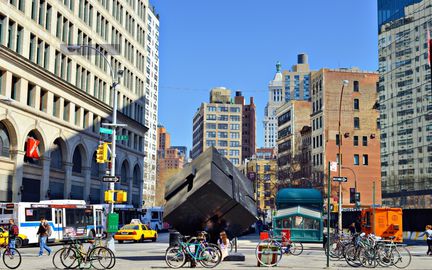

Most people think that Astor Place refers to a square, since the word 'place' derives from 'plaza', meaning public square. In reality the area that goes by the name of Astor Place is only a street, which runs from Third Avenue in the East through Cooper Square and Lafayette Street and then into Broadway in the West. Astor Place is the little artery that in the minds of New Yorkers connects the East Village to the West Village.
The street is named after entrepreneur and philanthropist John Jacob Astor, who was America's first multimillionaire. Astor, whose father was a butcher, was born in Germany in 1763 and immigrated first to England before arriving in the United States after the Revolutionary War. He began working in the fur trade, which involved doing business with American Indians, and in the first quarter of the 19th century saw his empire sprawl out from New York all the way to the West Coast, Canada included. He then became New York's leading real estate mogul, building entire neighborhoods such as Astoria, which today is in the borough of Queens. He was also an art collector and patron, and financed the foundation of one of New York's first public libraries, the Astor Library. His descendants continued expanding his business, making the Astor family one of the most illustrious in the city.
The most memorable landmark that stood on the street - right on the corner of Astor Place, Lafayette Street and Eighth Street - was the Astor Opera House. It was the city's most prominent opera stage throughout its two-year existence. It closed in 1849 after the famous Astor Place Riot, in which, during a performance of Shakespeare's Macbeth, the lower class workers rioted against the upper class, provoking the police to open fire on the participants, as well as innocent bystanders. The riot was actually a culmination of a long conflict between the classes, as well as nativist Americans and European immigrants. What is particular is that the conflict was symbolized by the professional rivalry between two actors: the American Edwin Forrest and the British William Charles Macready. Forrest was the hero of the American working class, while Macready was the darling of New York's plutocrats, who had promoted Anglophile policies. On the night of the riot it was Macready who was performing in the opera house. Thirty people died in the riot and over a hundred were injured. The bloody event surely had bad consequences for the theater, which was shut down immediately, but was great publicity for the two actors.
Today the traffic island in front of what was the Astor Opera House - and now Clinton Hall - is one of the most popular meeting places in the Eastern Village. In the center stands a black metal cube known as the Alamo, or simply the Cube. Weighing 1,800 pounds, it was built by sculptor Bernard Rosenthal and installed in 1967. Those who think they are strong can spin the cube on its vertical axis (though it is not recommended).
Just a few feet down Lafayette Street is the famous Off-Broadway Astor Place Theatre, which in the 60s and 70s was the breeding ground for actors such as Al Pacino and playwrights like Sam Shepard.